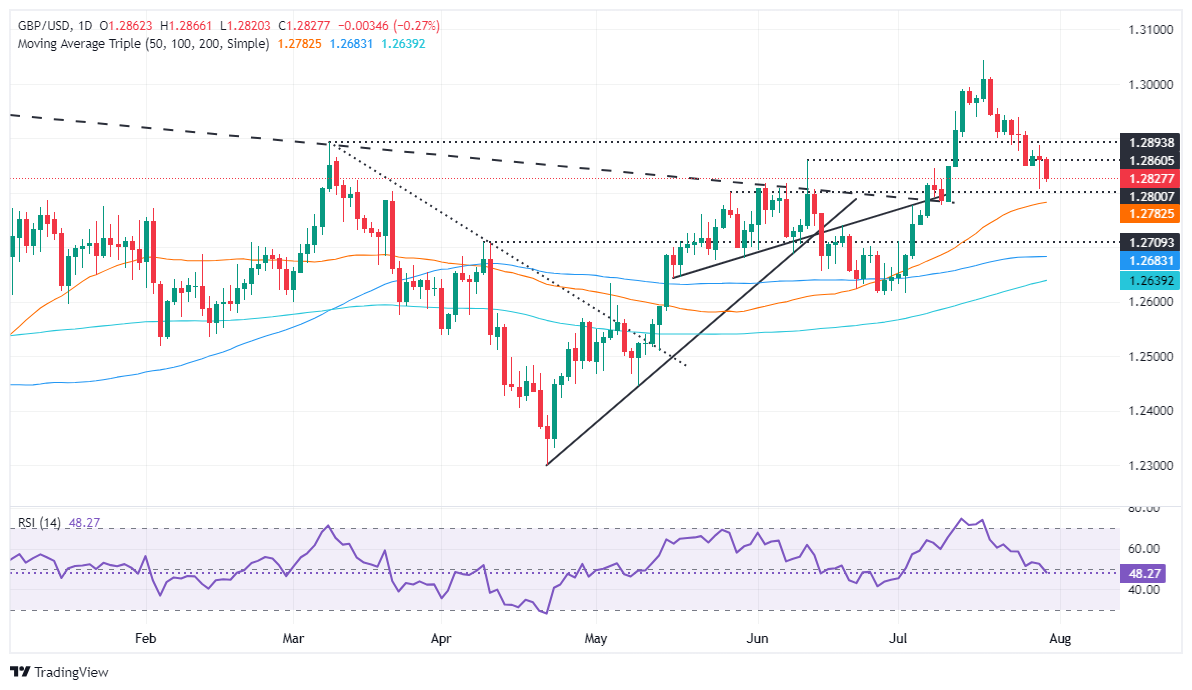- GBP/USD declines from daily high of 1.2866 amid strong US labor market data.
- Technical outlook shows bearish momentum, with key support at 1.2781 (50-DMA).
- Potential further declines to 1.2682 (100-DMA) if 1.2800 and 1.2739 support levels are breached.
The Pound Sterling dropped early during the North American session after economic data from the United States (US) came stronger than expected, highlighting a modestly tight labor market. Therefore, the GBP/USD edges down some 0.20% and trades at 1.2827 after hitting a daily high of 1.2866.
GBP/USD Price Analysis: Technical outlook
The GPB/USD extends its losses after peaking at a year-to-date (YTD) high of 1.3043, with buyers unable to fight back and lift the exchange rate above the previous cycle high seen on March 8 at 1.2893. Once the pair cleared the latter, the losses continued to pile up, with market participants eyeing a test of the 50-day moving average (DMA) at 1.2781.
The Relative Strength Index (RSI) hints that momentum favors sellers. Hence, the GBP/USD path of least resistance is tilted to the downside.
If GBP/USD drops beneath 1.2800, the next stop would be the abovementioned 50-DMA, followed by the June 19 high at 1.2739. If those levels are surpassed, the next stop would be beneath 1.2700 at the 100-DMA at 1.2682, followed by the 200-DMA at 1.2633.
For a bullish correction, the GBP/USD must clear the July 29 high of 1.2888 and the July 24 peak of 1.2937 so that buyers can challenge the YTD high.
GBP/USD Price Action – Daily Chart
Pound Sterling FAQs
The Pound Sterling (GBP) is the oldest currency in the world (886 AD) and the official currency of the United Kingdom. It is the fourth most traded unit for foreign exchange (FX) in the world, accounting for 12% of all transactions, averaging $630 billion a day, according to 2022 data. Its key trading pairs are GBP/USD, aka ‘Cable’, which accounts for 11% of FX, GBP/JPY, or the ‘Dragon’ as it is known by traders (3%), and EUR/GBP (2%). The Pound Sterling is issued by the Bank of England (BoE).
The single most important factor influencing the value of the Pound Sterling is monetary policy decided by the Bank of England. The BoE bases its decisions on whether it has achieved its primary goal of “price stability” – a steady inflation rate of around 2%. Its primary tool for achieving this is the adjustment of interest rates. When inflation is too high, the BoE will try to rein it in by raising interest rates, making it more expensive for people and businesses to access credit. This is generally positive for GBP, as higher interest rates make the UK a more attractive place for global investors to park their money. When inflation falls too low it is a sign economic growth is slowing. In this scenario, the BoE will consider lowering interest rates to cheapen credit so businesses will borrow more to invest in growth-generating projects.
Data releases gauge the health of the economy and can impact the value of the Pound Sterling. Indicators such as GDP, Manufacturing and Services PMIs, and employment can all influence the direction of the GBP. A strong economy is good for Sterling. Not only does it attract more foreign investment but it may encourage the BoE to put up interest rates, which will directly strengthen GBP. Otherwise, if economic data is weak, the Pound Sterling is likely to fall.
Another significant data release for the Pound Sterling is the Trade Balance. This indicator measures the difference between what a country earns from its exports and what it spends on imports over a given period. If a country produces highly sought-after exports, its currency will benefit purely from the extra demand created from foreign buyers seeking to purchase these goods. Therefore, a positive net Trade Balance strengthens a currency and vice versa for a negative balance.
Information on these pages contains forward-looking statements that involve risks and uncertainties. Markets and instruments profiled on this page are for informational purposes only and should not in any way come across as a recommendation to buy or sell in these assets. You should do your own thorough research before making any investment decisions. FXStreet does not in any way guarantee that this information is free from mistakes, errors, or material misstatements. It also does not guarantee that this information is of a timely nature. Investing in Open Markets involves a great deal of risk, including the loss of all or a portion of your investment, as well as emotional distress. All risks, losses and costs associated with investing, including total loss of principal, are your responsibility. The views and opinions expressed in this article are those of the authors and do not necessarily reflect the official policy or position of FXStreet nor its advertisers. The author will not be held responsible for information that is found at the end of links posted on this page.
If not otherwise explicitly mentioned in the body of the article, at the time of writing, the author has no position in any stock mentioned in this article and no business relationship with any company mentioned. The author has not received compensation for writing this article, other than from FXStreet.
FXStreet and the author do not provide personalized recommendations. The author makes no representations as to the accuracy, completeness, or suitability of this information. FXStreet and the author will not be liable for any errors, omissions or any losses, injuries or damages arising from this information and its display or use. Errors and omissions excepted.
The author and FXStreet are not registered investment advisors and nothing in this article is intended to be investment advice.
Recommended content
Editors’ Picks

EUR/USD corrects sharply toward 1.0950 ahead of US NFP, Powell
EUR/USD is extending its correction toward 1.0950 in the European session on Friday. The US Dollar has come up for air after the trade war and recession fears-led sell-off, weighing on the pair. Traders look to the US NFP report and Fed Chair Powell's speech for fresh directives.

GBP/USD remains heavy near 1.3000, US NFP data awaited
GBP/USD is battling 1.3000, under heavy selling pressure in European trading on Friday. Traders resort to profit-taking on their US Dollar short positiions, re-adjusting ahead of the critical US Nonfarm Payrolls data and Fed Chair Powell speech.

Gold price sticks to negative bias around $3,100; bears seem non-committed ahead of US NFP report
Gold price meets with a fresh supply on Friday, though the downside potential seems limited. Trump’s tariffs-inspired risk-off mood might continue to act as a tailwind for the precious metal. Fed rate cut bets weigh on the USD and also contribute to limiting losses for the XAU/USD pair.

Nonfarm Payrolls forecast: US jobs growth set to slow in March amid growing worries over US tariffs
Nonfarm Payrolls are forecast to rise by 135K in March, following a 151K gain reported in February. The United States Bureau of Labor Statistics will release the jobs data on Friday at 12:30 GMT. US labor data could impact the Fed’s interest rate path, potentially affecting the US Dollar's price action.

Trump’s “Liberation Day” tariffs on the way
United States (US) President Donald Trump’s self-styled “Liberation Day” has finally arrived. After four straight failures to kick off Donald Trump’s “day one” tariffs that were supposed to be implemented when President Trump assumed office 72 days ago, Trump’s team is slated to finally unveil a sweeping, lopsided package of “reciprocal” tariffs.

The Best brokers to trade EUR/USD
SPONSORED Discover the top brokers for trading EUR/USD in 2025. Our list features brokers with competitive spreads, fast execution, and powerful platforms. Whether you're a beginner or an expert, find the right partner to navigate the dynamic Forex market.




